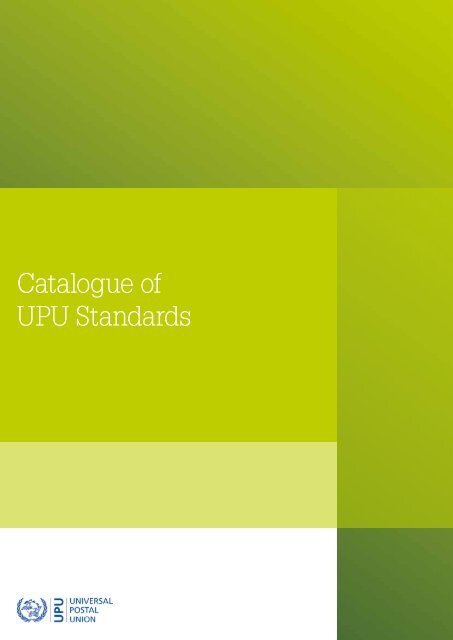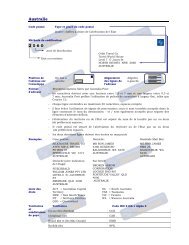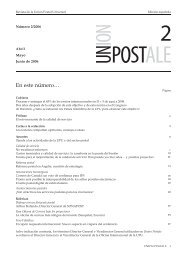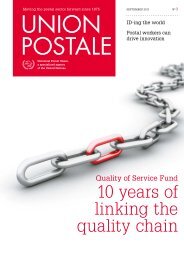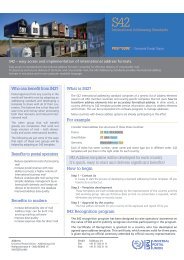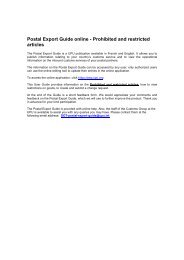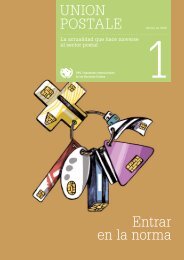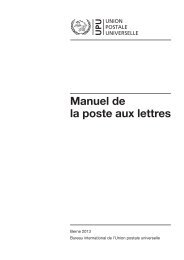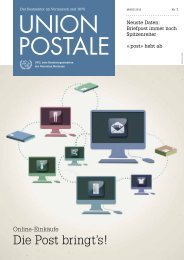Catalogue of UPU Standards - Universal Postal Union
Catalogue of UPU Standards - Universal Postal Union
Catalogue of UPU Standards - Universal Postal Union
Create successful ePaper yourself
Turn your PDF publications into a flip-book with our unique Google optimized e-Paper software.
<strong>Catalogue</strong> <strong>of</strong><br />
<strong>UPU</strong> <strong>Standards</strong>
Date <strong>of</strong> this version: 1 April 2014<br />
<strong>Catalogue</strong> <strong>of</strong> <strong>UPU</strong> <strong>Standards</strong><br />
<strong>UPU</strong> standards are updated in their entirety. Each update results in a new version, indicated by the version number following<br />
the number <strong>of</strong> the standard. Before using this document, please check in the <strong>Catalogue</strong> <strong>of</strong> <strong>UPU</strong> <strong>Standards</strong> that it is still valid.<br />
The <strong>Catalogue</strong> is freely available on the <strong>UPU</strong> website at www.upu.int.<br />
© <strong>UPU</strong> 2014 – All rights reserved i
Contents<br />
I. List <strong>of</strong> <strong>Standards</strong> ..................................................................................................................................... 1<br />
1 Sequential list <strong>of</strong> technical standards and their status .................................................................................. 1<br />
2 Sequential list <strong>of</strong> EDI messaging standards and their status ........................................................................ 3<br />
3 List <strong>of</strong> standards by type ............................................................................................................................... 5<br />
3.1 Physical encoding standards......................................................................................................................... 5<br />
3.2 Data definition and encoding standards ........................................................................................................ 5<br />
3.3 Electronic exchange standards ..................................................................................................................... 6<br />
3.4 Forms ............................................................................................................................................................ 6<br />
3.5 Standard interfaces ....................................................................................................................................... 6<br />
3.6 <strong>Postal</strong> security standards .............................................................................................................................. 6<br />
3.7 Technology standards ................................................................................................................................... 6<br />
II. Description <strong>of</strong> technical standards .................................................................................................. 7<br />
1 Physical encoding standards......................................................................................................................... 7<br />
2 Data definition and encoding standards ...................................................................................................... 10<br />
3 Electronic exchange standards ................................................................................................................... 12<br />
4 Forms .......................................................................................................................................................... 14<br />
5 Standard interfaces ..................................................................................................................................... 14<br />
6 <strong>Postal</strong> security standards ............................................................................................................................ 14<br />
7 Technology standards ................................................................................................................................. 15<br />
III. Description <strong>of</strong> messaging standards ............................................................................................. 16<br />
IV. Description <strong>of</strong> <strong>Standards</strong> at Status P ............................................................................................ 21<br />
ii<br />
© <strong>UPU</strong> 2014 – All rights reserved
Foreword<br />
<strong>Postal</strong> services form part <strong>of</strong> the daily life <strong>of</strong> people all over the world. The <strong>Universal</strong> <strong>Postal</strong> <strong>Union</strong> (<strong>UPU</strong>) is the<br />
specialised agency <strong>of</strong> the United Nations that regulates the universal postal service. The postal services <strong>of</strong> its<br />
192 member countries form the largest physical distribution network in the world. More than 5 million postal<br />
employees working in over 660 000 post <strong>of</strong>fices all over the world handle an annual total <strong>of</strong> 434 billion letter-post<br />
items in the domestic service and 5,5 billion in the international service. More than 6 billion parcels are sent by<br />
post annually. Keeping pace with the changing communications market, postal operators are increasingly using<br />
new communication and information technologies to move beyond what is traditionally regarded as their core<br />
postal business. They are meeting higher customer expectations with an expanded range <strong>of</strong> products and valueadded<br />
services.<br />
<strong>Standards</strong> are important prerequisites for effective postal operations and for interconnecting the global network.<br />
The <strong>UPU</strong>'s <strong>Standards</strong> Board develops and maintains a growing number <strong>of</strong> standards to improve the exchange <strong>of</strong><br />
postal-related information between postal operators and promotes the compatibility <strong>of</strong> <strong>UPU</strong> and international<br />
postal initiatives. It works closely with postal handling organisations, customers, suppliers and other partners,<br />
including various international organisations. The <strong>Standards</strong> Board ensures that coherent standards are<br />
developed in areas such as electronic data interchange (EDI), mail encoding, postal forms and meters.<br />
<strong>UPU</strong> standards are drafted in accordance with the rules set out in Part V <strong>of</strong> the "General information on <strong>UPU</strong><br />
standards" and are published by the <strong>UPU</strong> International Bureau in accordance with Part VII <strong>of</strong> that publication.<br />
© <strong>UPU</strong> 2014 – All rights reserved iii
I. List <strong>of</strong> <strong>Standards</strong><br />
1 Sequential list <strong>of</strong> technical standards and their status<br />
Standard Title<br />
Status<br />
number and<br />
version 1<br />
S1 Bar code symbology for postal receptacles W<br />
S2 Bar code symbology for postal items W<br />
S3 Airport identification W<br />
S4 Air carrier identification W<br />
S5 Country identification codes W<br />
S6 Offices <strong>of</strong> exchange W<br />
S7 <strong>Postal</strong> consignments W<br />
S8–6 <strong>Postal</strong> despatch identifier 2<br />
S9–8 <strong>Postal</strong> receptacle identifier 2<br />
S10–10 Identification <strong>of</strong> postal items – 13-character identifier 2<br />
S11 Item tracking events W<br />
S12 Format <strong>of</strong> message exchanges W<br />
S13 Standard messages for consignments W<br />
S14 Standard messages for despatches W<br />
S15 Standard messages for items W<br />
S16 Standard messages for transport W<br />
S17 Word processing document exchange W<br />
S18<br />
ID-tagging <strong>of</strong> letter mail items<br />
S18a–8 Part A: ID-tag structure, message and binary representations 1<br />
S18b–7 Part B: BNB-78 encoding specification 1<br />
S18c–6 Part C: BNB-62 encoding specification S<br />
S18d–10 Part D: 4-state encoding specification for flats 1<br />
S18e–5 Part E: 4-state encoding specification for small letters 0<br />
S19<br />
Encoding on envelopes – Placement area definitions<br />
S19a–10 Part A: General concepts and definition <strong>of</strong> the coordinate system 1<br />
S19b–10 Part B: Areas used by postal handling organisations for the encoding <strong>of</strong> ID-tags and 1<br />
routing information<br />
S19c–9 Part C: Areas used for postmarks, indicia and service endorsements 1<br />
S19d–2 Part D: Areas used for the printing <strong>of</strong> addresses and associated customer applied 0<br />
encoding<br />
S20–3 Identification and marking using Radio Frequency Identification Technology: Reference W<br />
architecture and terminology<br />
S21–3 Data presentation in ASN.1 0<br />
S22–3 Identification and marking using Radio Frequency Identification Technology: System<br />
requirements and test procedures<br />
0<br />
1 When a standard is updated the document version number changes. It is the responsibility <strong>of</strong> the user to ensure that they<br />
have the most current version <strong>of</strong> any standard.<br />
© <strong>UPU</strong> 2014 – All rights reserved 1
Standard Title<br />
Status<br />
number and<br />
version 1<br />
S23 Radio Frequency Identification (RFID) and Radio Data Capture (RDC) Systems –<br />
Air Interfaces: Communications and Interfaces<br />
S23a Part A: Definitions <strong>of</strong> parameters to be standardized W<br />
S23b Part B: Parameter Values for 5.8 GHz RFID Systems W<br />
S23c Part C: Parameter Values for 2.45 GHz Narrow Band RFID Systems W<br />
S23e Part E: Parameters for air interface communications at 860 MHz to 960 MHz W<br />
S23f Part F: Parameter Values for 433 MHz / 125 KHz RFID Systems W<br />
S23g Part G: Parameter Values for 13.56 MHz Band RFID Systems W<br />
S24–5 Representation <strong>of</strong> postal information using data identifiers 0<br />
S25–9 Data constructs for the communication <strong>of</strong> information on postal items, batches and 0<br />
receptacles<br />
S26–7 License plates for parcels 0<br />
S27–2 Framework for communication <strong>of</strong> information about postal items, batches and<br />
0<br />
receptacles<br />
S28–3 Communication <strong>of</strong> postal information using two-dimensional symbols 0<br />
S29 Bar-coded receptacle labels W<br />
S30–4 International postage meter approval requirements 1<br />
S31–4 <strong>UPU</strong> issuing agency – Assignment <strong>of</strong> issuer codes 1<br />
S32–3 <strong>Postal</strong> consignments 2<br />
S33–1 Interoperability framework for postal public key infrastructures 0<br />
S34–8 Registration <strong>of</strong> international mail processing centres 0<br />
S35–4 <strong>UPU</strong> issuing agency – Assignment and use <strong>of</strong> party identifiers 1<br />
S36–4 Digital Postage Marks (DPM) – Applications, security and design 0<br />
S37–4 Receptacle asset numbering 0<br />
S39–2 Trusted Time Stamp 1<br />
S40–4 Human and OCR data capture – Error detection – Algorithm for the generation and 0<br />
checking <strong>of</strong> an error detection code<br />
S41–3 Identification and publication <strong>of</strong> <strong>UPU</strong> code lists 1<br />
S42<br />
International postal address components and templates<br />
S42a–7 Part A: Conceptual hierarchy and template languages 1<br />
S42b–7 Part B: Element mapping conventions, template design considerations, address<br />
1<br />
templates and rendition instructions<br />
S43<br />
Secured electronic postal services (SePS) interface specification<br />
S43a–4 Part A: Concepts, schemas and operations 1<br />
S43b–4 Part B: EPCM Service 1<br />
S44–1 Colour and durability attributes <strong>of</strong> franking marks 0<br />
S45–2 OCR and Human readable representation <strong>of</strong> data on postal items, labels and forms 0<br />
S46–3 Linear bar coded representation <strong>of</strong> data on postal items, labels and forms 0<br />
S47–3 <strong>Postal</strong> receptacle labels 1<br />
S48–1 <strong>Postal</strong>-4i: 4-state symbology and its use for the encoding <strong>of</strong> data on postal items 0<br />
S49–1 Customer applied encoding <strong>of</strong> data on postal items 0<br />
S50–1 Interface between machine control and bar code printers 0<br />
S51–2 Interface between image controller and enrichment devices (OCRs, video coding 0<br />
systems, voting systems)<br />
S52–2 Functional specification for postal registered electronic mail 1<br />
2 © <strong>UPU</strong> 2014 – All rights reserved
Standard Title<br />
Status<br />
number and<br />
version 1<br />
S53–1 Exchange <strong>of</strong> name and address data 0<br />
S54–1 Extensible <strong>Postal</strong> Product Model and Language (EPPML) 0<br />
S55–1 Identification <strong>of</strong> postal items – Identifier structures and encoding principles 0<br />
S56–1 Air interface parameter values for 433 MHz / 125 KHz RFID Systems 1<br />
S57–1 Statement <strong>of</strong> mailing submission 0<br />
S58–2 <strong>Postal</strong> security – General security measures 1<br />
S59–2 <strong>Postal</strong> security – Office <strong>of</strong> exchange and international airmail security 1<br />
S60–1 Extensible Common Structure and Representation for <strong>Postal</strong> Rates (EPR) 0<br />
S61–1 Radio Frequency Identification (RFID) and Radio Data Capture (RDC) standards – RFID 0<br />
Reference architecture and air interfaces<br />
S62–1 International mail processing centres: assignment and use <strong>of</strong> operator codes 0<br />
S63–1 Design definition for form completion instructions 0<br />
S64–1 <strong>Postal</strong> identity management: General concepts, definition <strong>of</strong> related terms and common 0<br />
protocols<br />
S65–1 Open interface – Sortplan 0<br />
2 Sequential list <strong>of</strong> EDI messaging standards and their status<br />
Standard Title<br />
Status<br />
number and<br />
version 2<br />
M5–6 Dataflows<br />
M10–7 PRECON Message specification, Version 1.1 2<br />
M11 PREDES Message specification, Version 1.1 W<br />
M12–5 RESCON Message specification, Version 1.1 2<br />
M13–4 RESDES Message specification, Version 1.1 2<br />
M14–8 PREDES Message specification, Version 2.0 2<br />
M15 TRAKIT Message specification, Version 1.0 W<br />
M16 EMSEVT Message specification, Version 0 W<br />
M17–6 EMSEVT Message specification, Version 1.0 2<br />
M18–8 CARDIT Message specification, Version 1.1 S<br />
M19 TRAKIT Message specification, Version 2.0 W<br />
M20–6 CARDIT Message specification, Version 2.0 S<br />
M21–4 EXCEPT Message specification, Version 1.0 0<br />
M22–7 RESDIT Message specification, Version 1.0 S<br />
M23 MONORD Message specification, Version 1.0 W<br />
M24 RESORD Message specification, Version 1.0 W<br />
M25 TRAKIT Message specification, Version 3.0 W<br />
M26–1 CAPREQ – Capacity request Message specification 0<br />
M27–1 CAPOFF – Capacity <strong>of</strong>fer Message specification 0<br />
M28 UPIMEX – <strong>UPU</strong> Customs Import/Export Declaration, Version 1.4 W<br />
2 When a standard is updated the document version number changes. It is the responsibility <strong>of</strong> the user to ensure that they<br />
have the most current version <strong>of</strong> any standard.<br />
© <strong>UPU</strong> 2014 – All rights reserved 3
Standard Title<br />
Status<br />
number and<br />
version 2<br />
M29 UPIRES – Customs response for postal items, Version 1.0 W<br />
M30–7 Electronic Data Interchange between postal handling organisations 0<br />
M31<br />
<strong>Postal</strong> addresses and their electronic communication – EDIFACT directory 00A W<br />
representation <strong>of</strong> postal addresses<br />
M32<br />
Communication <strong>of</strong> mail item content piece information between postal handling W<br />
organisations<br />
M33–9 ITMATT V1 – Electronic communication <strong>of</strong> item information 0<br />
M34 Electronic communication <strong>of</strong> mail aggregate information W<br />
M35 Communication <strong>of</strong> mail transport information between postal handling organisations W<br />
M36 Despatch attributes and the communication <strong>of</strong> despatch information – PREDES V3.1 W<br />
M37–6 <strong>Postal</strong> processing events and event reporting 0<br />
M38–6 International Money Orders – XML-MONORD and XML-RESORD messages 1<br />
M39–5 CARDIT/RESDIT – Data flow version 2: Introduction and examples<br />
M40–6 EMSEVT Message specification, Version 3.0 1<br />
M41–5 PREDES Message specification, Version 2.1 1<br />
M42–2 eVN – Electronic Verification Notes 0<br />
M43<br />
CUSITM/CUSRSP Message specification<br />
M43a–2 Part A: CUSITM, CUStoms ITeM 0<br />
M43b–2 Part B: CUSRSP, CUStoms ReSPonse 0<br />
M45–1 REFDIS Message specification, Version 1 0<br />
M46–1 REFACK Message specification, Version 1 0<br />
M47–4 CARDIT Message specification, Version 1.2 0<br />
M48–4 CARDIT Message specification, Version 2.1 0<br />
M49–4 RESDIT Message specification, Version 1.1 0<br />
M50–1 e53 – electronic statement <strong>of</strong> sampling 0<br />
M80 Logical Data Model – Entity relationship diagram W<br />
M81 Logical Data Model – Entity definitions W<br />
M82 Logical Data Model – Attribute definitions W<br />
M83 Logical Data Model – Relationship definitions W<br />
M84–2 <strong>UPU</strong> Logical Data Model (LDM) 0<br />
M85–4 Data dictionary for messages based on <strong>UPU</strong> standard M30 0<br />
4 © <strong>UPU</strong> 2014 – All rights reserved
3 List <strong>of</strong> standards by type<br />
S18<br />
S18a<br />
S18b<br />
S18c<br />
S18d<br />
S18e<br />
S19<br />
S19a<br />
S19b<br />
S19c<br />
S19d<br />
S22<br />
S26<br />
S28<br />
S36<br />
S37<br />
S40<br />
S44<br />
S45<br />
S46<br />
S48<br />
S49<br />
S56<br />
S61<br />
3.1 Physical encoding standards<br />
ID-tagging <strong>of</strong> letter mail items<br />
Part A: ID-tag structure, message and binary representations<br />
Part B: BNB-78 encoding specification<br />
Part C: BNB-62 encoding specification<br />
Part D: 4-state encoding specification for flats<br />
Part E: 4-state encoding specification for small letters<br />
Encoding on envelopes – Placement area definitions<br />
Part A: General concepts and definition <strong>of</strong> the coordinate system<br />
Part B: Areas used by postal handling organisations for the encoding <strong>of</strong> ID-tags and routing<br />
information<br />
Part C: Areas used for postmarks, indicia and service endorsements<br />
Part D: Areas used for the printing <strong>of</strong> addresses and associated customer applied encoding<br />
Identification and marking using Radio Frequency Identification Technology – System<br />
requirements and test procedures<br />
License plates for parcels<br />
Communication <strong>of</strong> postal information using two-dimensional symbols<br />
Digital Postage Marks (DPM) – Applications, security and design<br />
Receptacle asset numbering<br />
Human and OCR data capture – Error detection – Algorithm for the generation and checking <strong>of</strong> an<br />
error detection code<br />
Colour and durability attributes <strong>of</strong> franking marks<br />
OCR and Human readable representation <strong>of</strong> data on postal items, labels and forms<br />
Linear bar coded representation <strong>of</strong> data on postal items, labels and forms<br />
<strong>Postal</strong>-4i: 4-state symbology and its use for the encoding <strong>of</strong> data on postal items<br />
Customer applied encoding <strong>of</strong> data on postal items<br />
Air interface parameter values for 433 MHz / 125 KHz RFID Systems<br />
Radio Frequency Identification (RFID) and Radio Data Capture (RDC) standards – RFID<br />
Reference architecture and air interfaces<br />
S8<br />
S9<br />
S10<br />
S21<br />
S24<br />
S25<br />
S27<br />
S31<br />
S32<br />
S34<br />
S35<br />
S41<br />
3.2 Data definition and encoding standards<br />
<strong>Postal</strong> despatch identifier<br />
<strong>Postal</strong> receptacle identifier<br />
Identification <strong>of</strong> postal items – 13-character identifier<br />
Data presentation in ASN.1<br />
Representation <strong>of</strong> postal information using data identifiers<br />
Data constructs for the communication <strong>of</strong> information on postal items, batches and receptacles<br />
Framework for communication <strong>of</strong> information about postal items, batches and receptacles<br />
<strong>UPU</strong> issuing agency – Assignment <strong>of</strong> issuer codes<br />
<strong>Postal</strong> consignments<br />
Registration <strong>of</strong> international mail processing centres<br />
<strong>UPU</strong> issuing agency: Assignment and use <strong>of</strong> party identifiers<br />
Identification and publication <strong>of</strong> <strong>UPU</strong> code lists<br />
© <strong>UPU</strong> 2014 – All rights reserved 5
S42<br />
S42a<br />
S42b<br />
S55<br />
S62<br />
International postal address components and templates<br />
Part A: Conceptual hierarchy and template languages<br />
Part B: Element mapping conventions, template design considerations, address templates and<br />
rendition instructions<br />
Identification <strong>of</strong> postal items – Identifier structures and encoding principles<br />
International mail processing centres: assignment and use <strong>of</strong> operator codes<br />
S33<br />
S39<br />
S43<br />
S43a<br />
S43b<br />
S52<br />
S53<br />
S57<br />
3.3 Electronic exchange standards<br />
(Electronic exchange standards include EDI messaging standards listed above<br />
in 2, Sequential list <strong>of</strong> EDI messaging standards and their status)<br />
Interoperability framework for postal public key infrastructures<br />
Trusted Time Stamp<br />
Secure electronic postal services (SEPS) interface specification<br />
Part A: Concepts, schemas and operations<br />
Part B: EPCM Service<br />
Functional specification for postal registered electronic mail<br />
Exchange <strong>of</strong> name and address data<br />
Statement <strong>of</strong> mailing submission<br />
S47<br />
S63<br />
3.4 Forms<br />
<strong>Postal</strong> receptacle labels<br />
Design definition for form completion instructions<br />
S50<br />
S51<br />
S65<br />
3.5 Standard interfaces<br />
Interface between machine control and bar code printers<br />
Interface between image controller and enrichment devices (OCRs, video coding systems, voting<br />
systems)<br />
Open interface – Sortplan<br />
S58<br />
S59<br />
3.6 <strong>Postal</strong> security standards<br />
<strong>Postal</strong> security – General security measures<br />
<strong>Postal</strong> security – Office <strong>of</strong> exchange and international airmail security<br />
S30<br />
S54<br />
S60<br />
S64<br />
3.7 Technology standards<br />
International postage meter approval requirements<br />
Extensible <strong>Postal</strong> Product Model and Language (EPPML)<br />
Extensible Common Structure and Representation for <strong>Postal</strong> Rates (EPR)<br />
<strong>Postal</strong> identity management: General concepts, definition <strong>of</strong> related terms and common protocols<br />
6 © <strong>UPU</strong> 2014 – All rights reserved
II.<br />
Description <strong>of</strong> technical standards<br />
The following pages provide a brief description <strong>of</strong> <strong>UPU</strong> technical standards grouped according to type (information<br />
on relationships to other standards is found in the standard document itself).<br />
1 Physical encoding standards<br />
S1 Bar code symbology for postal receptacles WITHDRAWN<br />
Please refer to document S47, <strong>Postal</strong> receptacle labels, for the current standard.<br />
S2 Bar code symbology for postal items WITHDRAWN<br />
S18<br />
S18a<br />
S18b<br />
S18c<br />
S18d<br />
S18e<br />
S19<br />
S19a<br />
S19b<br />
Please refer to document S10, Identification <strong>of</strong> postal items – 13-character ID, which replaces this<br />
standard.<br />
ID-tagging <strong>of</strong> letter mail items<br />
Part A: ID-tag structure, message and binary representations<br />
S18 was originally published as a single part standard, but has been split into parts in order to<br />
simplify the specification <strong>of</strong> different ID-tag encoding formats. Part A provides the definition <strong>of</strong> IDtags<br />
and specifies their general construction and representation for electronic data interchange<br />
purposes. Their representation on items is covered by subsequent parts <strong>of</strong> the standard, which<br />
define a number <strong>of</strong> alternative printed representations.<br />
Part B: BNB-78 encoding specification<br />
Provides a specification <strong>of</strong> the encoding <strong>of</strong> <strong>UPU</strong> ID-tags on items using a 78-position bar-no-bar<br />
code, referred to as BNB-78.<br />
Part C: BNB-62 encoding specification<br />
Provides a specification <strong>of</strong> the encoding <strong>of</strong> <strong>UPU</strong> ID-tags on items using a 62-position bar-no-bar<br />
code, referred to as BNB-62, which is compliant with the ID-tag format in use by An Post (Ireland),<br />
Canada Post and USPS. It is published only to provide other parties with the specifications<br />
necessary to enable them to read ID-tags printed by these three organisations and should not be<br />
used as the basis for printing ID-tags by any other issuer.<br />
Part D: 4-state encoding specification for flats<br />
Provides a specification <strong>of</strong> the encoding <strong>of</strong> <strong>UPU</strong> ID-tags using a 4-state symbology that may be<br />
applied to flats.<br />
Part E: 4-state encoding specification for small letters<br />
Provides a specification <strong>of</strong> the encoding <strong>of</strong> <strong>UPU</strong> ID-tags using a 4-state symbology that may be<br />
applied to the front side <strong>of</strong> small letters.<br />
Encoding on envelopes – Placement area definitions<br />
Part A: General concepts and definition <strong>of</strong> the coordinate system<br />
This standard provides a definition <strong>of</strong> encoding areas on letter-mail items. It is divided into three<br />
parts.<br />
Part A provides definitions for the terms and coordinate system used in other parts <strong>of</strong> the standard.<br />
Part B: Areas used by postal handling organisations for the encoding <strong>of</strong> ID-tags and routing<br />
information<br />
Part B defines areas, on both the front and back <strong>of</strong> letter-post items <strong>of</strong> size up to C4 (229 mm by<br />
324 mm), that can be used by postal handling organisations for the encoding <strong>of</strong> ID-tags and routing<br />
information required to supported automated processing <strong>of</strong> the items concerned.<br />
© <strong>UPU</strong> 2014 – All rights reserved 7
S19c<br />
S19d<br />
S20<br />
S22<br />
S23<br />
S23a<br />
Part C: Areas used for postmarks, indicia and service endorsements<br />
Part C provides a formal definition <strong>of</strong> areas used for postmarks, indicia and service endorsements.<br />
These areas can, depending on the circumstances, be used by either the mailer or a postal<br />
handling organisation.<br />
Part D: Areas used for the printing <strong>of</strong> addresses and associated customer applied coding<br />
Part D deals with the definition <strong>of</strong> areas that are, or can be, used for the printing <strong>of</strong> addresses and<br />
customer applied barcodes which are printed together with the delivery address.<br />
Identification and marking using Radio Frequency Identification<br />
Technology – Reference architecture and terminology<br />
Please refer to document S61 for the current standard.<br />
WITHDRAWN<br />
Identification and marking using Radio Frequency Identification Technology – System<br />
requirements and test procedures<br />
This is the second <strong>of</strong> four standards dealing with RFID systems, which can be used to automatically<br />
identify postal items. This standard provides a number <strong>of</strong> definitions, categorisations, and tests in<br />
order to enable users and suppliers <strong>of</strong> <strong>UPU</strong> RFID systems to specify system requirements that<br />
guarantee interoperability.<br />
Radio Frequency Identification (RFID) and Radio Data Capture (RDC) Systems – Air<br />
interfaces: Communications and interfaces<br />
WITHDRAWN<br />
Part A: Definitions <strong>of</strong> parameters to be standardised<br />
WITHDRAWN<br />
Please refer to document S61 for the current standard.<br />
S23b Part B: Parameter values for 5.8 GHz RFID systems WITHDRAWN<br />
NOTE 18000–5 Parameters for Air Interface Communications at 5.8 GHz provided physical layer,<br />
anti-collision system and protocol values for RFID systems for item identification operating at 5.8–<br />
5.9 GHz in accordance with the requirements <strong>of</strong> ISO 18000–1. This standard has been withdrawn.<br />
S23c Part C: Parameter values for 2.45 GHz narrow band RFID systems WITHDRAWN<br />
Please refer to document S61 and ISO/IEC 18000–1 and ISO/IEC 18000–4.<br />
S23e Part E: Parameters for air interface communications at 860 MHz to 960 MHz WITHDRAWN<br />
Please refer to document S61, ISO/IEC 18000–1 and ISO/IEC 18000–6.<br />
S23f Part F: Parameter values for 433 MHz / 125 KHz RFID systems WITHDRAWN<br />
Please refer to document S56 for the current standard.<br />
S23g Part G: Parameter values for 13.56MHz RFID systems WITHDRAWN<br />
S26<br />
S28<br />
Please refer to document S61, ISO/IEC 18000–1 and ISO/IEC 18000–3.<br />
License plates for parcels<br />
This standard defines a <strong>UPU</strong> implementation <strong>of</strong> the ISO 15459 license plate and associated label<br />
for the identification <strong>of</strong> parcels. It provides an open international standards-based identification for<br />
parcels and allows all parties (e.g. customers, Customs, and private transport providers) which<br />
handle a particular parcel to use the same identifier for automatic reading and tracking purposes.<br />
This common identity is useful as an alternative to a more limited identifier assigned by a postal<br />
enterprise.<br />
Communication <strong>of</strong> postal information using two-dimensional symbols<br />
This standard describes the use <strong>of</strong> two-dimensional digital indicia or array codes to convey postal<br />
information in the form <strong>of</strong> symbols printed on postal items, on item or receptacle labels and on<br />
accompanying documentation. The standard is intended for application in all cases in which postal<br />
information and identifiers are encoded, using two-dimensional symbols, on postal items,<br />
receptacles, labels and forms which are exchanged between postal operators. It may also<br />
beneficially be applied in cases in which only a single postal operator is involved.<br />
8 © <strong>UPU</strong> 2014 – All rights reserved
S36<br />
S37<br />
S40<br />
S44<br />
S45<br />
S46<br />
S48<br />
S49<br />
Digital Postage Marks (DPM) – Applications, security and design<br />
The standard presents a recommended process for designing digital postage mark applications, i.e.<br />
applications linked to the use <strong>of</strong> digital printing and image data capture technologies in the postal<br />
industry, most particularly for the evidencing <strong>of</strong> postage accounting and/or payment.<br />
The process described is based on a cyclic model, involving business planning; systems analysis;<br />
security analysis and detailed DPM design.<br />
Receptacle asset numbering<br />
This standard specifies a mechanism for the unique identification <strong>of</strong> individual receptacles. It<br />
defines the method <strong>of</strong> construction <strong>of</strong> the identifier, referred to as the receptacle asset number, and<br />
specifies one required and a number <strong>of</strong> optional methods by which this identifier may be associated<br />
with (affixed to) the receptacle itself.<br />
Human and OCR data capture – Error detection – Algorithm for the generation and checking<br />
<strong>of</strong> an error detection code<br />
This specification defines an algorithm for calculating an error detection code, which may be<br />
appended to human-readable printed character data, to protect against data capture errors which<br />
may occur if the printed data is captured using either manual data entry or OCR data capture<br />
techniques.<br />
Colour and durability attributes <strong>of</strong> franking marks<br />
This standard defines the colour and durability attributes <strong>of</strong> franking marks that are to be read by a<br />
given postal operator. It applies to all franking marks including those that use two-dimensional<br />
digital indicia known as Digital Postage Marks (DPM). It also applies to both the machine-readable<br />
and human-readable information contained in the franking mark. It is assumed that compliance with<br />
this standard for machine-readable information will yield human-readable franking marks.<br />
OCR and Human readable representation <strong>of</strong> data on postal items, labels and forms<br />
This standard provides general guidelines in cases in which information, other than postal<br />
addresses, is printed on postal items, labels and forms in human-readable/OCR form which is<br />
intended to be captured by or used in computer systems. It applies both to cases in which the data<br />
capture is automated, using OCR technology, and to cases in which data capture is partially or<br />
completely based on keyboard entry and/or voice recognition.<br />
Linear bar coded representation <strong>of</strong> data on postal items, labels and forms<br />
This standard describes the use <strong>of</strong> Code 39 and Code 128 linear bar codes to convey postal<br />
information in the form <strong>of</strong> symbols printed on postal items, on item or receptacle labels and on<br />
accompanying documentation. It recommends the physical parameters, orientation and placement<br />
<strong>of</strong> linear bar codes required to ensure a high level <strong>of</strong> readability in the postal processing<br />
environment.<br />
<strong>Postal</strong>-4i: 4-state symbology and its use for the encoding <strong>of</strong> data on postal items<br />
This standard specifies one particular method <strong>of</strong> data representation, referred to as a 4-state bar<br />
coding symbology, in which information is conveyed in the form <strong>of</strong> a linear bar code consisting <strong>of</strong> an<br />
evenly spaced series <strong>of</strong> bars <strong>of</strong> constant width, with each bar representing, through its length and<br />
vertical positioning, the value <strong>of</strong> two bits <strong>of</strong> data.<br />
Customer applied encoding <strong>of</strong> data on postal items<br />
This standard deals with the customer encoding <strong>of</strong> data on postal items in the form <strong>of</strong> printed<br />
characters or marks, such as bar codes and two-dimensional symbols. Probably the most common<br />
<strong>of</strong> these is the customer bar-coding <strong>of</strong> service, routing and/or delivery point information, such as a<br />
postcode. This has the advantage that its capture, in the postal system, is easier, cheaper and<br />
more accurate than the capture <strong>of</strong> data from a character-based representation as part <strong>of</strong> a printed<br />
address. This has led many postal operators to encourage such encoding, <strong>of</strong>ten linked to the<br />
induction <strong>of</strong> mail in pre-sorted batches which by-pass one or more sorting steps within the postal<br />
system, by <strong>of</strong>fering discounts. A second key application is the customer encoding <strong>of</strong> item identifiers,<br />
enabling the postal operator to provide, and mailers to obtain, information about the progress and<br />
delivery <strong>of</strong> the items and batches <strong>of</strong> mail they send.<br />
© <strong>UPU</strong> 2014 – All rights reserved 9
S56<br />
S61<br />
Air interface parameter values for 433 MHz / 125 KHz RFID Systems<br />
This document provides parameter definitions for RFID systems for automatic quality measurement<br />
systems operating at 433 MHz / 125 KHz in accordance with the requirements <strong>of</strong> ISO 18000–1.<br />
Radio Frequency Identification (RFID) and Radio Data Capture (RDC) standards – RFID<br />
Reference architecture and air interfaces<br />
This document specifies a reference architecture to support unambiguous automatic identification<br />
<strong>of</strong> individual mail units and containers through association with devices (RFID tags or labels) whose<br />
identity can be automatically captured by radio frequency communication with interrogators<br />
(readers) when they are within, or pass through, the detection range <strong>of</strong> the interrogators concerned.<br />
It specifies the transactions and data interchanges across the air interface (architecture reference<br />
point delta) between an interrogator and an RFID tag and identifies the parameters that need to be<br />
determined in any specific instance <strong>of</strong> such an air interface. It defines the specific parameters<br />
applicable to such air interfaces in cases in which the radio communications between RFID tags<br />
and interrogators takes place within one <strong>of</strong> the following approved world-wide frequency bands:<br />
13,56 MHz, 433 MHz, 860 MHz to 960 MHz; and 2,45 GHz.<br />
2 Data definition and encoding standards<br />
S3 Airport identification WITHDRAWN<br />
Please refer to IATA 3-character location (airport, city) codes<br />
S4 Air carrier identification WITHDRAWN<br />
Please refer to IATA 2-character air carrier codes<br />
S5 Country identification codes WITHDRAWN<br />
Please refer to ISO 3166 alpha-2 country codes<br />
S6 Offices <strong>of</strong> exchange WITHDRAWN<br />
Please refer to document S34, Registration <strong>of</strong> international mail processing centres, for the current<br />
standard.<br />
S7 <strong>Postal</strong> consignments WITHDRAWN<br />
S8<br />
S9<br />
S10<br />
Please refer to document S32, <strong>Postal</strong> consignments, for the current standard.<br />
<strong>Postal</strong> despatch identifier<br />
A postal despatch is a collection <strong>of</strong> mail – normally in bags or other receptacles – that is being<br />
transported from one international mail processing centre to another. A despatch is identified by a<br />
unique 20-character dynamic identifier which contains information about the despatch.<br />
<strong>Postal</strong> receptacle identifier<br />
A postal receptacle is a container used for the transportation <strong>of</strong> a uniquely identifiable collection <strong>of</strong><br />
one or more letters, packets, empty bags, or items being transported together as part or all <strong>of</strong> a<br />
despatch. Its contents are identified by a unique 29-character dynamic identifier which contains<br />
information about the receptacle. This identifier fulfils various objectives relating to operations,<br />
quality <strong>of</strong> service, security, and accounting.<br />
Identification <strong>of</strong> postal items – 13-character identifier<br />
This document provides the specification for 13-character item identifiers for universal use, as<br />
referenced in <strong>UPU</strong> regulations and in publications <strong>of</strong> the <strong>UPU</strong>’s EMS Cooperative. The standard<br />
may also be applied to the identification <strong>of</strong> domestic items, as well as items exchanged under<br />
bilateral or multilateral agreements. A postal item identifier that is compliant with this standard can<br />
be used to identify the individual postal item to which it relates by means <strong>of</strong> a representation <strong>of</strong> the<br />
identifier printed on the item or a label or form that is affixed to it.<br />
10 © <strong>UPU</strong> 2014 – All rights reserved
S11 Item tracking events WITHDRAWN<br />
S21<br />
S24<br />
S25<br />
S27<br />
S31<br />
S32<br />
S34<br />
S35<br />
This standard defined item tracking events which were used in the TRAKIT EDI messages. Since<br />
TRAKIT (M19) has been withdrawn there is no reference to S11 in any other standard, therefore it<br />
has been withdrawn.<br />
Data presentation in ASN.1<br />
This standard is part <strong>of</strong> a series <strong>of</strong> standards for the <strong>UPU</strong>, for use in automatic data capture<br />
techniques (such as RFID and digital indicia). The document specifies the general presentation<br />
rules for transfer <strong>of</strong> ASN.1 data schemes between <strong>UPU</strong> members.<br />
Representation <strong>of</strong> postal information using data identifiers<br />
This standard defines an architecture for the construction <strong>of</strong> data constructs which may be used to<br />
represent postal information and identifiers. The standard is consistent with data identifiers as<br />
defined in ISO 15418 and is applicable to post-specific data constructs which relate to data<br />
exchanged between postal enterprises, and/or between postal enterprises and third parties, based<br />
on the use <strong>of</strong> data identifiers. It also addresses the definition <strong>of</strong> license plates and defines a means<br />
<strong>of</strong> structuring them which is compliant with ISO 15459.<br />
Data constructs for the communication <strong>of</strong> information on postal items, batches and<br />
receptacles<br />
This standard provides a dictionary <strong>of</strong> data constructs for use in the communication <strong>of</strong> information<br />
about postal items and batches. It contains both simple data constructs, which correspond to<br />
elementary items <strong>of</strong> information about an item or group <strong>of</strong> items, and compound data constructs,<br />
which are built up from a series <strong>of</strong> simple constructs.<br />
Framework for communication <strong>of</strong> information about postal items, batches and receptacles<br />
This standard defines a reference framework for the communication <strong>of</strong> data concerning both<br />
individual and batches <strong>of</strong> postal items. It supports the integration <strong>of</strong> such data, with data stored in<br />
postal processing systems and databases, for the purpose <strong>of</strong> postal process and enterprise<br />
management. The standard applies to the communication <strong>of</strong> all data, exchanged between postal<br />
operators, in a form which is, or is intended to be, directly captured and interpreted by postal<br />
information technology systems. Its application in other situations requiring the communication <strong>of</strong><br />
postal data in processable form is strongly encouraged.<br />
<strong>UPU</strong> Issuing Agency – Assignment <strong>of</strong> issuer codes<br />
Several <strong>UPU</strong> standards make use <strong>of</strong> the concept <strong>of</strong> an identifier for individual postal<br />
operators/users <strong>of</strong> the standard concerned. These and any similar future standards should utilise a<br />
common identification system for these organisations. This standard provides for assignment <strong>of</strong><br />
issuer codes for use in association with the <strong>UPU</strong> issuing agency code.<br />
<strong>Postal</strong> consignments<br />
A postal consignment is a collection <strong>of</strong> mail receptacles – normally bags or containers <strong>of</strong> mail – that<br />
is being transported as a whole from one location to another. A consignment is identified by a code<br />
<strong>of</strong> up to 12 characters, consisting <strong>of</strong> the ISO country code and a unique alphanumeric identifier.<br />
Registration <strong>of</strong> international mail processing centres<br />
This document defines the mechanism for registering international mail processing centres<br />
(IMPCs), for the allocation <strong>of</strong> IMPC codes and for update and publication <strong>of</strong> the IMPC register in the<br />
form <strong>of</strong> <strong>UPU</strong> code list 108; successor to withdrawn standard S6.<br />
<strong>UPU</strong> Issuing Agency – Assignment and use <strong>of</strong> party identifiers<br />
This document defines the allocation and use <strong>of</strong> identification codes which may be used to identify<br />
parties <strong>of</strong> interest to postal operators and other mail service contractors. The mechanism chosen<br />
supports a system <strong>of</strong> global identification for any type <strong>of</strong> party, including customers and suppliers.<br />
© <strong>UPU</strong> 2014 – All rights reserved 11
S41<br />
S42<br />
S42a<br />
S42b<br />
S55<br />
S62<br />
Identification and publication <strong>of</strong> <strong>UPU</strong> code lists<br />
Many <strong>UPU</strong> standards make use <strong>of</strong> codes to represent data values for the purpose <strong>of</strong><br />
communications between parties. Wherever possible, use is made <strong>of</strong> code lists which are defined<br />
and maintained by other international standards-setting organisations such as ISO or the<br />
UN/EDIFACT Board. However, certain code lists which are specific to postal applications are<br />
necessarily defined in <strong>UPU</strong> standards and managed by the <strong>UPU</strong> <strong>Standards</strong> Board. Such code lists<br />
are published on the <strong>UPU</strong> world-wide website and can be accessed under URL: http://www.upu.int.<br />
To allow reference to them, each <strong>of</strong> these code lists is associated with a code list identifier. This<br />
standard specifies the method <strong>of</strong> allocation and publication <strong>of</strong> such identifiers in a master code list.<br />
International postal address components and templates<br />
Part A: Conceptual hierarchy and template languages<br />
This part <strong>of</strong> the standard provides a methodology for the specification <strong>of</strong> postal address templates,<br />
which stipulate how a postal address is to be written, including the order in which postal address<br />
elements are to appear, required and optional elements, and the presentation or rendition <strong>of</strong> the<br />
elements, subject to constraints on the space available for that task. Languages suitable for human<br />
comprehension and computer processing <strong>of</strong> postal address templates are defined and described. It<br />
also provides a dictionary <strong>of</strong> the possible components <strong>of</strong> postal addresses, together with examples<br />
<strong>of</strong> and constraints on their use.<br />
Part B: Element mapping conventions, template design considerations, address templates<br />
and rendition instructions<br />
This part <strong>of</strong> the standard describes the address templates for each country, i.e. the specific way an<br />
address is formatted in each country, indicating in particular the order in which the various elements<br />
appear. The address templates may include rendition instructions, specifying how elements are to<br />
be rendered for printing.<br />
Identification <strong>of</strong> postal items – Identifier structures and encoding principles<br />
This standard provides an overall introduction to, and specification <strong>of</strong>, all forms <strong>of</strong> individual item<br />
identification that are supported by <strong>UPU</strong> standards.<br />
International mail processing centres: assignment and use <strong>of</strong> operator codes<br />
This standard defines a mechanism for the allocation <strong>of</strong> operator codes to organisations authorized<br />
by <strong>UPU</strong> members to operate international mail processing centres (IMPCs), i.e. mail processing<br />
facilities involved in the creation, transit routeing and/or receipt <strong>of</strong> mail despatches, in accordance<br />
with <strong>UPU</strong> standards and/or documentation.<br />
3 Electronic exchange standards<br />
S12 Format <strong>of</strong> message exchanges WITHDRAWN<br />
S13 Standard messages for consignments WITHDRAWN<br />
S14 Standard messages for despatches WITHDRAWN<br />
S15 Standard messages for items WITHDRAWN<br />
S16 Standard messages for transport WITHDRAWN<br />
S17 Word processing document exchange WITHDRAWN<br />
S33<br />
Interoperability framework for postal public key infrastructures<br />
The objective <strong>of</strong> this standard is to create a common <strong>Postal</strong> Public Key Infrastructure (PKI) to<br />
provide global certification and security services aimed at globally binding the identity <strong>of</strong> individuals<br />
and organisations with their public key. The framework itself and its first four elements (PKI<br />
structure, cryptographic algorithms, data formats and data dissemination protocols) are included in<br />
the initial draft standard.<br />
12 © <strong>UPU</strong> 2014 – All rights reserved
S39<br />
S43<br />
S43a<br />
S43b<br />
S52<br />
S53<br />
S57<br />
Trusted Time Stamp<br />
The standardisation <strong>of</strong> the trusted time stamp can be seen as the electronic replacement <strong>of</strong> the<br />
present postmark on regular mail. As such, the service requires electronic security features to<br />
reproduce some characteristics <strong>of</strong> the traditional postmark such as a time and date stamp given by<br />
a postal operator acting as a trusted third party in a communication.<br />
The service is a first example <strong>of</strong> a Global <strong>Postal</strong> Trust Service (GPTS) allowing <strong>Postal</strong> operators to<br />
bring e-mail up to the same level <strong>of</strong> acceptance that hard-copy mail currently enjoys. Via the trusted<br />
time stamp service, e-mail messages will be given, by the <strong>Postal</strong> operators acting as a trusted third<br />
party, a tamper-detection feature with a secure time and date stamp (i.e. the trusted time stamp).<br />
Secure electronic postal services (SEPS) interface specification<br />
Part A: Concepts, schemas and operations<br />
This document specifies a standard XML interface that will enable s<strong>of</strong>tware applications to call a<br />
secured electronic postal service (SePS), provided by a postal operator. It also describes the<br />
functionality and edit rules <strong>of</strong> the actual technical specification artifacts, which are represented by<br />
an XML Schema (XSD) and an associated Web Services Definition Language (WSDL)<br />
specification.<br />
Part B: EPCM Service<br />
This document specifies a secured electronic postal service, referred to as the Electronic <strong>Postal</strong><br />
Certification Mark (EPCM) service, which provides a chain <strong>of</strong> evidence, stored by an operator as a<br />
trusted third party, to prove the existence <strong>of</strong> an electronic event, for a certain content, at a certain<br />
date and time, and involving one or more identified parties.<br />
Functional specification for postal registered electronic mail<br />
This standard defines the functional specification <strong>of</strong> a secure electronic postal service, referred to<br />
as the postal registered electronic mail or PReM service. PReM provides a trusted and certified<br />
electronic mail exchange between mailer, designated operators and addressee/mailee. In addition,<br />
evidence <strong>of</strong> corresponding events and operations within the scope <strong>of</strong> PReM will be generated and<br />
archived for future attestation.<br />
Exchange <strong>of</strong> name and address data<br />
This standard facilitates the electronic communication <strong>of</strong> international name and address data sets<br />
from mailer to postal operator; from postal operator to postal operator; from postal operator to<br />
mailer and between mailers. It supports such communication both in the form <strong>of</strong> S42 data elements<br />
and in the form used in printed postal addresses. The standard is based on two W3C XML<br />
Schemas and relies on S42 for definitions <strong>of</strong> elements, element sub-types and country based<br />
templates.<br />
Statement <strong>of</strong> mailing submission<br />
This standard specifies a methodology that allows postal operators to define statements <strong>of</strong> mailing<br />
submission customised according to their environment and applications. It defines information that<br />
could be collected within the mailer’s domain and transmitted to the postal domain to support<br />
processing applications related to major postal functions, namely operations, finance and<br />
marketing. It also defines the organisation <strong>of</strong> data originating in the mailer’s domain into messages<br />
by describing data content, format and communication protocols and provides a detailed analysis<br />
and recommendations for implementing countermeasures against application level security threats,<br />
particularly those relating to postal revenue protection in controlled mail entry settings.<br />
© <strong>UPU</strong> 2014 – All rights reserved 13
4 Forms<br />
S29 Bar-coded receptacle labels WITHDRAWN<br />
S47<br />
S63<br />
Please refer to document S47, <strong>Postal</strong> receptacle labels, for the current standard.<br />
<strong>Postal</strong> receptacle labels<br />
This standard complements the Letter and Parcel Post Regulations by providing a rigorous<br />
specification <strong>of</strong> the content and layout <strong>of</strong> CN 34, CN 35, CN 36, CP 83, CP 84 and CP 85<br />
receptacle labels. It supersedes and replaces earlier <strong>UPU</strong> standard S29-2, which covered only bar<br />
coded receptacle labels and should be used in preference to S29-2 for all new and updated<br />
implementations. The standard applies to all labels <strong>of</strong> these types whether used to label a<br />
receptacle or, in the case <strong>of</strong> CP 83 and CP 84, to label a loose parcel. The standard covers only<br />
labelling requirements related to the above-mentioned list <strong>of</strong> label types. The Regulations should be<br />
consulted for details <strong>of</strong> other labelling requirements, such as the marking <strong>of</strong> receptacles containing<br />
perishable infectious biological substances or radioactive materials.<br />
Design definition for form completion instructions<br />
This standard provides design definitions for documents containing form completion instructions<br />
(FCDs). It also defines the process for validating and publishing such documents.<br />
5 Standard interfaces<br />
S50<br />
S51<br />
S65<br />
Interface between machine control and bar code printers<br />
This standard specifies the electrical, data and timing interface between the control unit <strong>of</strong> a postal<br />
sorting system and an ink jet printer connected to that system. It further specifies an ancillary<br />
interface to the printer, which can be used for the support <strong>of</strong> remote diagnostics and other service<br />
functions.<br />
Interface between image controller and enrichment devices (OCRs, video coding systems,<br />
voting systems)<br />
This document specifies a standard interface between the image control unit <strong>of</strong> a postal sorting<br />
system and image enrichment devices including OCR systems, video coding systems and voting<br />
systems whose purpose is to choose between the results obtained from other enrichment devices.<br />
Open interface – Sortplan<br />
This standard specifies the sort plan file content and structure. The content <strong>of</strong> a sort plan allows the<br />
specification <strong>of</strong> the following capabilities: sorting by address and non-address attributes; sorting <strong>of</strong><br />
code ranges; sorting <strong>of</strong> rejects; support <strong>of</strong> display and label texts; dynamic outlet groups; sorting to<br />
more than one outlet; overflow handling; support <strong>of</strong> cut <strong>of</strong>f time before despatch; sequence sorting;<br />
provide volume information (option); support <strong>of</strong> Cards; possibility to add simple manufacturer<br />
specific information; support <strong>of</strong> various sort code formats and non-address attributes; support <strong>of</strong><br />
various display and label formats; check against characteristics <strong>of</strong> the sorting machine.<br />
6 <strong>Postal</strong> security standards<br />
S58<br />
S59<br />
<strong>Postal</strong> security – General security measures<br />
This standard defines the minimum physical and process security requirements applicable to critical<br />
facilities within the postal network.<br />
<strong>Postal</strong> security – Office <strong>of</strong> exchange and international airmail security<br />
This standard defines the minimum requirements for mail screening standards that shall be<br />
implemented at each <strong>of</strong>fice <strong>of</strong> exchange or airmail unit or where mail is tendered to air carriers. It<br />
comprises the minimum requirements within the postal sector and applies a risk based approach in<br />
identifying items within the international postal supply chain to subject to screening.<br />
14 © <strong>UPU</strong> 2014 – All rights reserved
7 Technology standards<br />
S30<br />
S54<br />
S60<br />
S64<br />
International postal meter approval requirements<br />
The aim <strong>of</strong> this standard is to provide a means <strong>of</strong> testing the revenue protection acceptability <strong>of</strong><br />
technology employed for the production <strong>of</strong> postal metered indicia printed onto envelopes by<br />
customers or their agents, and to provide a consistent international approach to the procedures for<br />
testing devices which print postal indicia. It specifies the security requirements that are to be<br />
satisfied for revenue-sensitive modules utilised within a security system protecting postal meters.<br />
The standard is intended to cover the wide range <strong>of</strong> potential applications and environments in<br />
which meters may be employed.<br />
Extensible <strong>Postal</strong> Product Model and Language (EPPML)<br />
This standard defines an XML-based mechanism for the formal definition <strong>of</strong> postal products. It<br />
supports the specification <strong>of</strong> an almost unlimited variety <strong>of</strong> such products by reference to service<br />
characteristics and pricing and in terms <strong>of</strong> the requirements that have to be fulfilled by both<br />
individual items and mailing submissions in order to qualify for treatment in accordance with the<br />
product definition. The use <strong>of</strong> product definition applications based on the standard will enable<br />
postal operators to formally specify existing products and to create new products tailored to specific<br />
customer requirements. Mailers will be able to use the resulting product definitions to assist them in<br />
selecting the product most appropriate to the needs <strong>of</strong> particular mailings and, subject to the use <strong>of</strong><br />
mailing equipment that supports use <strong>of</strong> the standard, to generate mailings that fully comply with<br />
product access requirements.<br />
Extensible Common Structure and Representation for <strong>Postal</strong> Rates (EPR)<br />
This standard defines a uniform structure and meaning for the information that fully represents<br />
postal rates for a broad variety <strong>of</strong> postal products in all mail categories. It contains a complete<br />
description <strong>of</strong> the EPR schema, its hierarchical structure, information types and semantics <strong>of</strong> its<br />
elements. Such representation <strong>of</strong> postal rates allows automated systems to uniformly use postal<br />
rates as they are introduced for new products or updated for existing postal products by postal<br />
operators.<br />
<strong>Postal</strong> identity management: General concepts, definition <strong>of</strong> related terms and common<br />
protocols<br />
This standard describes identity management elements and identifies common protocols used to<br />
exchange identity assertions and attributes for the purpose <strong>of</strong> enabling customer access to<br />
applications in the postal network. The identity elements are defined to ensure interoperability <strong>of</strong><br />
credentials issued by postal operators or by others for use in the postal network. It defines the<br />
terms and functions <strong>of</strong> postal identity management processes and environment. It is intended to<br />
provide a basic understanding <strong>of</strong> identity management roles, technologies, activities and principles.<br />
© <strong>UPU</strong> 2014 – All rights reserved 15
III. Description <strong>of</strong> messaging standards<br />
M5<br />
Dataflows<br />
This standard provides an overview <strong>of</strong> existing postal EDI messages and how they are intended to<br />
be used and interact. The sequential logical order <strong>of</strong> message exchanges is shown in a number <strong>of</strong><br />
diagrams. Explanatory text gives additional details about the purpose and timing <strong>of</strong> the messages<br />
described. References to other existing standards are also included in order to give a broader<br />
picture concerning various existing standards and how they are used together.<br />
M10 PRECON Message specification, Version 1.1<br />
PRE-ADVICE OF CONSIGNMENT HANDED OVER<br />
The PRECON message contains information about a consignment <strong>of</strong> mail which has been<br />
prepared for hand over to a carrier. Its purpose is to provide planning information to the postal<br />
operator which will next handle the consignment and the means to automate the checking-in <strong>of</strong> mail<br />
as it is received by that postal operator.<br />
M11 PREDES Message specification, Version 1.1 WITHDRAWN<br />
Please refer to document M14, PREDES Version 2.0, which replaces this standard.<br />
M12 RESCON Message specification, Version 1.1<br />
ADMINISTRATION CONFIRMATION OF CONSIGNMENT RECEIPT/CURRENT EXCEPTIONS<br />
The RESCON message contains information about a consignment <strong>of</strong> mail which has been received<br />
from a carrier. Its purpose is to provide information which can be used to assist with the<br />
measurement <strong>of</strong> the quality <strong>of</strong> service delivered by the transport provider(s). This can be achieved<br />
by monitoring the arrival <strong>of</strong> containers and receptacles against the pre-advised transport<br />
information.<br />
M13 RESDES Message specification, Version 1.1<br />
ADMINISTRATION CONFIRMATION OF DESPATCH RECEIPT/CURRENT EXCEPTIONS<br />
The RESDES message contains information about receptacles <strong>of</strong> a despatch <strong>of</strong> mail that has been<br />
processed at a destination exchange <strong>of</strong>fice. Its purpose is to provide details to the exchange <strong>of</strong>fice<br />
<strong>of</strong> origin concerning the status <strong>of</strong> the receptacles processed so that quality <strong>of</strong> service can be<br />
assessed, as well as to support accounting functions.<br />
M14 PREDES Message specification, Version 2.0<br />
PRE-ADVICE OF DESPATCH PREPARED<br />
The PREDES version 2 message contains information about a despatch <strong>of</strong> mail which has been<br />
prepared by an exchange <strong>of</strong>fice for delivery to an exchange <strong>of</strong>fice in another country. The message<br />
describes the individual receptacles <strong>of</strong> the despatch and the individual items in each receptacle. Its<br />
purpose is to provide: planning information to the postal operator which will receive the despatch at<br />
one <strong>of</strong> its exchange <strong>of</strong>fices; the means to automate the checking-in <strong>of</strong> mail as it is received by that<br />
postal operator at the exchange <strong>of</strong>fice; and support accounting functions.<br />
M15 TRAKIT Message specification, Version 1.0 WITHDRAWN<br />
Withdrawn – no longer in use.<br />
M16 EMSEVT Message specification, Version 0 WITHDRAWN<br />
This document has been withdrawn – please refer to document M17, EMSEVT Version 1, which<br />
replaces this standard.<br />
16 © <strong>UPU</strong> 2014 – All rights reserved
M17 EMSEVT Message specification, Version 1.0<br />
EMS EVENTS MESSAGE<br />
The EMSEVT message provides a mechanism for the reporting <strong>of</strong> events occurring to postal items<br />
which have individual item identifiers. The original specification was drawn up to support the<br />
reporting <strong>of</strong> events occurring to international EMS items but it can be applied to other classes <strong>of</strong><br />
item including parcels and special (identified) letter mail items such as registered, insured and<br />
Express letters.<br />
M18 CARDIT Message specification, Version 1.1<br />
CARRIER/DOCUMENTS INTERNATIONAL TRANSPORT<br />
The CARDIT message contains information about a consignment <strong>of</strong> mail which is handed over to a<br />
carrier.<br />
M19 TRAKIT Message specification, Version 2.0 WITHDRAWN<br />
Withdrawn – no longer in use.<br />
M20 CARDIT Message specification, Version 2.0<br />
CARRIER/DOCUMENTS INTERNATIONAL TRANSPORT<br />
The CARDIT message contains information about a consignment <strong>of</strong> mail which is handed over to a<br />
carrier. This version has the same functionality as version 1.1. The only difference is the EDIFACT<br />
Directory in which the message is implemented.<br />
M21 EXCEPT Message specification, Version 1.0<br />
ADMINISTRATION CONFIRMATION OF RECEIPT/CURRENT EXCEPTIONS<br />
The exception message contains information about the receipt and/or processing <strong>of</strong> receptacles for<br />
which no pre-advice message has been received.<br />
M22 RESDIT Message specification, Version 1.0<br />
CARRIER/CONFIRMATION OF RECEIPT OR CURRENT EXCEPTION<br />
The RESDIT message contains information about a consignment <strong>of</strong> mail as it is processed by a<br />
carrier. The sending <strong>of</strong> the CARDIT message is mandatory to receive a RESDIT message. The<br />
CARDIT/RESDIT messages are defined to work together. It is not possible to send a RESDIT<br />
message if a CARDIT has not been received.<br />
M23 MONORD Message specification, Version 1.0 WITHDRAWN<br />
Withdrawn – no longer in use. Please refer to M38.<br />
M24 RESORD Message specification, Version 1.0 WITHDRAWN<br />
Withdrawn – no longer in use. Please refer to M38.<br />
M25 TRAKIT Message specification, Version 3.0 WITHDRAWN<br />
M26<br />
Withdrawn – no longer in use.<br />
CAPREQ – Capacity request message specification<br />
The Capacity Request message is sent normally from a postal operator to a carrier upon discovery<br />
that the mail cannot be transported as scheduled or as agreed bilaterally. The trigger could come<br />
from the postal side (deviated volumes, delays in the domestic network, problems at destination<br />
operator, etc.) or from the carrier side (flight cancelled, cargo space insufficient, delays due to<br />
weather conditions, etc.). The Capacity Request message contains information about volumes <strong>of</strong><br />
mail for which the postal operator is looking for transport on a short term or for a certain period. This<br />
message covers the different scenarios defined within the FACTEUR MESSAGING subgroup.<br />
© <strong>UPU</strong> 2014 – All rights reserved 17
M27<br />
CAPOFF – Capacity <strong>of</strong>fer message specification<br />
The Capacity Offer message is sent from a carrier to a postal operator in response to a Capacity<br />
Request message or upon discovery that transport capacity is available. The Capacity Offer<br />
message contains information about the volumes <strong>of</strong> mail, which can be carried, on a specific<br />
journey. If a carrier has several alternative <strong>of</strong>fers for the same capacity request, each <strong>of</strong>fer is<br />
reported in a separate capacity <strong>of</strong>fer message. This message covers the different scenarios defined<br />
within the FACTEUR MESSAGING-subgroup.<br />
M28 UPIMEX – <strong>UPU</strong> Customs Import/Export Declaration, Version 1.4 WITHDRAWN<br />
Please refer to document M43a, CUSITM/CUSRSP Message specification – Part A: CUSITM,<br />
CUStoms ITeM for the current standard.<br />
M29 UPIRES – Customs response for postal items, Version 1.0 WITHDRAWN<br />
M30<br />
M31<br />
M32<br />
M33<br />
Please refer to document M43b, CUSITM/CUSRSP Message specification – Part B: CUSRSP,<br />
CUStoms ReSPonse for the current standard.<br />
Electronic Data Interchange between postal handling organisations<br />
This specification defines the concept <strong>of</strong> using messages to exchange information between postal<br />
handling organisations and describes the organisation <strong>of</strong> such exchanges into interchanges. It<br />
further defines XML and EDIFACT implementation <strong>of</strong> these electronic data interchange (EDI)<br />
concepts.<br />
<strong>Postal</strong> addresses and their electronic communication – EDIFACT directory 00A<br />
representation <strong>of</strong> postal addresses<br />
WITHDRAWN<br />
This document has been withdrawn and its contents incorporated into M85 and M33.<br />
Communication <strong>of</strong> mail item content piece information between postal handling<br />
organisations<br />
WITHDRAWN<br />
This document has been withdrawn and its contents incorporated into M85 and M33.<br />
ITMATT V1 – Electronic communication <strong>of</strong> item information<br />
For process management and control purposes, postal handling organisations need information on<br />
the characteristics or attributes <strong>of</strong> mail items which they are called upon to handle. M33 specifies<br />
how item information is encoded for electronic communications purposes and defines ITMATT, a<br />
message that supports such communications.<br />
M34 Electronic communication <strong>of</strong> mail aggregate information WITHDRAWN<br />
M35<br />
This document has been withdrawn. The communication <strong>of</strong> aggregate information is supported by<br />
PREDES V2.1 (M41).<br />
Communication <strong>of</strong> mail transport information between postal handling organisations<br />
WITHDRAWN<br />
This document has been withdrawn; relevant parts <strong>of</strong> its content have been incorporated into M85.<br />
M36 Despatch attributes and the communication <strong>of</strong> despatch information – PREDES V3.1<br />
WITHDRAWN<br />
M37<br />
This document has been withdrawn; use <strong>of</strong> PREDES V2.1 (M41) is recommended for the<br />
communication <strong>of</strong> despatch information.<br />
<strong>Postal</strong> processing events and event reporting<br />
This document provides the logical specification for and EDIFACT directory 00A implementation <strong>of</strong><br />
the EVTRPT version 2.0 Event reporting message which can be used to communicate information<br />
about an arbitrary collection <strong>of</strong> events. EVTRPT can be used for the reporting both <strong>of</strong> events which<br />
have occurred and/or are expected or planned to occur or should have occurred to mail items,<br />
aggregates and/or receptacles. For each reported event, it identifies the entity and event<br />
concerned, defines the date, time and location <strong>of</strong> the event and reports on the resulting status <strong>of</strong><br />
the entity.<br />
18 © <strong>UPU</strong> 2014 – All rights reserved
M38<br />
M39<br />
Electronic exchange standards – International Money Orders – XML-MONORD and XML-<br />
RESORD messages<br />
This document provides an XML-based specification <strong>of</strong> messages for the communication <strong>of</strong><br />
international money orders and money order cancellation requests, and for the sending <strong>of</strong> advices<br />
to report on the execution status <strong>of</strong> money orders. The specified request message, MONORD,<br />
supersedes and replaces <strong>UPU</strong> standard M23 and the specified response message, RESORD,<br />
supersedes and replaces <strong>UPU</strong> standard M24.<br />
CARDIT/RESDIT – Data flow version 2: Introduction and examples<br />
The CARDIT message contains information about a consignment <strong>of</strong> mail which is handed over to a<br />
carrier. The RESDIT message contains information about a consignment <strong>of</strong> mail as it is received by<br />
the carrier. With Version 2 <strong>of</strong> the CARDIT and RESDIT dataflows, it is no longer required to receive<br />
a CARDIT message in order to send a RESDIT message.<br />
This document provides a general introduction to and examples for CARDIT and RESDIT data flow<br />
version 2. It also outlines their definition and interconnectivity.<br />
M40 EMSEVT Message specification, Version 3<br />
This specification defines a means <strong>of</strong> exchanging information about key events in the movement <strong>of</strong><br />
an item from posting/collection through to final delivery. It can be used to track identified items, e.g.<br />
EMS, parcels, registered and/or insured letter post, and express letter post as they move through<br />
the postal network. It is broadly based on design principles consistent with those for EMSEVT V1<br />
(M17), particularly in regards to the use <strong>of</strong> a single EDI message segment to refer to a specific<br />
tracking point. It can be considered as an enhancement to EMSEVT V1 which accommodates<br />
business requirements identified in consultation with user groups for the capture and exchange <strong>of</strong><br />
additional tracking points and the associated operational information, and basic support for the use<br />
<strong>of</strong> non-S10-format item identifiers.<br />
M41 PREDES Message specification, Version 2.1<br />
M42<br />
M43<br />
M43a<br />
M43b<br />
The PREDES version 2.1 message contains information about a despatch <strong>of</strong> mail which has been<br />
prepared by an origin <strong>of</strong>fice <strong>of</strong> exchange for transportation to a destination <strong>of</strong>fice <strong>of</strong> exchange,<br />
typically in another country. It describes the despatch-level information such as the despatch<br />
identification data and the planned transport, the individual receptacles <strong>of</strong> the despatch and the<br />
individually identified (track-able) items in each receptacle. From a functional perspective, PREDES<br />
V2.1 is an enhancement <strong>of</strong> PREDES V2.0 (M14). It adds support for the use <strong>of</strong> electronic despatch<br />
pre-advises for accounting purposes and provides basic support for the use <strong>of</strong> non-S10-format item<br />
identifiers.<br />
eVN – Electronic Verification Notes<br />
This document defines the structure <strong>of</strong> an XML interchange file which supports the electronic<br />
communication <strong>of</strong> the variable data content <strong>of</strong> one or more electronic Verification Notes, together<br />
with references to or electronic copies <strong>of</strong> supporting attachments, including corrected versions <strong>of</strong><br />
and/or substitutes or replacements for other forms. It also defines a human readable representation<br />
<strong>of</strong> the data in an electronic Verification Note.<br />
CUSITM/CUSRSP Message specification<br />
CUSITM – CUStoms ITeM<br />
CUSITM is a message for a postal operator to transmit mail item information to the local customs. It<br />
covers the electronic representation <strong>of</strong> existing <strong>UPU</strong> paper forms CN 22/CN 23 and CP 72, agreed<br />
standards between the <strong>UPU</strong> and the WCO (the World Customs Organization), plus additional<br />
attributes.<br />
CUSRSP – CUStoms ReSPonse<br />
CUSRSP is a message for a customs organisation to transmit mail item information to the local<br />
designated postal operator, usually in response to a CUSITM message. Both parties must agree on<br />
the exact usage <strong>of</strong> the message. The intended business benefit for both parties is to automate and<br />
therefore speed up the customs process.<br />
© <strong>UPU</strong> 2014 – All rights reserved 19
M45 REFDIS Message specification, Version 1<br />
REFDIS – REFerence data DIStribution is an XML message through which a party can send<br />
reference data and reference data updates to another party. The structure <strong>of</strong> the message is<br />
generically designed to cover many types <strong>of</strong> reference data lists.<br />
M46 REFACK Message specification, Version 1<br />
REFACK – REFerence data receipt ACKnowledgement is an XML message through which a party<br />
can acknowledge receipt <strong>of</strong> reference data and reference data updates to a party that generated a<br />
REFDIS message with such reference data.<br />
M47 CARDIT Message specification, Version 1.2<br />
The CARDIT message contains information about a consignment <strong>of</strong> mail which is handed over to a<br />
carrier. It is a consignment-level message. CARDIT V1.2 is based on EDIFACT directory 91.2. As it<br />
is a “post-defined” message based on the IFTMFR (International Forwarding and Transport<br />
Message Framework), it diverges somewhat from the true framework. It can be considered an<br />
enhancement <strong>of</strong> M18 CARDIT V1.1.<br />
M48 CARDIT Message specification, Version 2.1<br />
The CARDIT message contains information about a consignment <strong>of</strong> mail which is handed over to a<br />
carrier. It is a consignment-level message. CARDIT V2.1 is based on EDIFACT directory D96.A<br />
and is a true subset <strong>of</strong> the IFCSUM (Forwarding and consolidation summary message) standard<br />
EDIFACT message. It can be considered as an enhancement <strong>of</strong> M20 CARDIT V2.0<br />
M49 RESDIT Message specification, Version 1.1<br />
M50<br />
M80<br />
M81<br />
M82<br />
M83<br />
M84<br />
M85<br />
The RESDIT message (carrier/confirmation <strong>of</strong> receipt or current exception) contains information<br />
about a consignment <strong>of</strong> mail as it is received by the carrier. With Version 2 <strong>of</strong> the CARDIT and<br />
RESDIT dataflows it is no longer required to receive a CARDIT message in order to send a<br />
RESDIT message. It can be considered as an enhancement <strong>of</strong> M22 RESDIT V1.0.<br />
e53 – electronic statement <strong>of</strong> sampling<br />
The e53 message is the electronic representation <strong>of</strong> <strong>UPU</strong> form CN 53. It contains information about<br />
letter receptacles which have been sampled as part <strong>of</strong> the <strong>UPU</strong> sampling process. It lists each<br />
receptacle sampled in a defined period, with the corresponding attributes and sampling information.<br />
The e53 message is initially sent by the destination operator that received the receptacles and<br />
performed the sampling to the operator that originated the receptacles. Further exchanges between<br />
the two parties may occur when data adjustments are required.<br />
Logical Data Model – Entity relationship diagram<br />
Logical Data Model – Entity definitions<br />
Logical Data Model – Attribute definitions<br />
Logical Data Model – Relationship definitions<br />
WITHDRAWN<br />
WITHDRAWN<br />
WITHDRAWN<br />
WITHDRAWN<br />
M80, M81, M82 and M83 are withdrawn standards. Please refer to document M84 for the current<br />
model.<br />
<strong>UPU</strong> Logical Data Model (LDM)<br />
Data elements used in <strong>UPU</strong> EDI messaging standards are based on a common Logical Data Model<br />
(LDM). This model defines data elements that are being exchanges in the various EDI messages<br />
and describes the relationships between them.<br />
Data dictionary for messages based on <strong>UPU</strong> standard M30<br />
M30 defines the concept <strong>of</strong> using messages to exchange information between postal handling<br />
organisations and describes the organisation <strong>of</strong> such exchanges into interchanges. It provides the<br />
conceptual basis for a number <strong>of</strong> related EDI specifications including M33, M37 and M42. Since the<br />
attribute information which can be conveyed using these messages overlaps, the data definitions<br />
concerned are documented in M85, which provides a common data dictionary for all messages<br />
based on M30.<br />
20 © <strong>UPU</strong> 2014 – All rights reserved
IV. Description <strong>of</strong> <strong>Standards</strong> at Status P<br />
Status P means that the <strong>Standards</strong> Board has endorsed the work required to develop an idea. The subject <strong>of</strong> the<br />
standard is recognised and the first notes on how to proceed are listed. At this stage a full, detailed proposal is not<br />
required. There should, however, be the basis <strong>of</strong> a study to be carried out. A description <strong>of</strong> how the project should<br />
proceed must be included. After this, status P can be granted. The following names and descriptions <strong>of</strong> standards<br />
at Status P are in order <strong>of</strong> approval by the <strong>Standards</strong> Board.<br />
P5<br />
P10<br />
P17<br />
P19<br />
P25<br />
Electronic communication <strong>of</strong> mail piece images and related item attributes<br />
This work item is intended to lead to a standard covering the exchange <strong>of</strong> images and related item<br />
attributes, linked to the use <strong>of</strong> ID-tags (such as the ID-tag for letter mail, S18) or other means <strong>of</strong><br />
item identification. The objective is to enable images to be captured at one point in the postal<br />
handling process but processed at another point, using equipment from a different supplier (i.e. the<br />
standard will support open interchange).<br />
See POC TSB 1998.3–Doc 3h for original work item proposal.<br />
Process management and tracking <strong>of</strong> mail aggregates<br />
CEN/TS 14441: <strong>Postal</strong> services – Mail aggregates – Creation, processing and tracking defines<br />
mechanisms for the process management and tracking <strong>of</strong> mail aggregates. It is intended to be<br />
applied to mail which transfers between postal operators with the objective <strong>of</strong> facilitating<br />
improvements in quality <strong>of</strong> service and process control, thus helping postal operators meet the<br />
expectations <strong>of</strong> their increasingly demanding and sophisticated customers. If there is sufficient<br />
interest, the specification can be endorsed by the <strong>UPU</strong> and published as a <strong>UPU</strong> standard. Pending<br />
a decision on this, interested parties can obtain the CEN specification, though it should be noted<br />
that the current (2005) version <strong>of</strong> this is not fully consistent with some more recent <strong>UPU</strong> standards.<br />
The CEN specification can be obtained through any national standards organisation which is<br />
affiliated to CEN. Links to these can be found on www.cen.eu.<br />
See POC SB 2000.3–Doc 3b for original work item proposal.<br />
Customer-applied item identifiers<br />
This covers the development <strong>of</strong> a standard for the encoding by customers <strong>of</strong> information,<br />
particularly item identifiers, on postal items. Rather than an identifier applied by postal operators<br />
strictly for postal purposes (such as the ID-tag), this identifier would be for use by both postal<br />
operators and their customers.<br />
Much <strong>of</strong> the work intended under this work item has been completed, and is reflected in S49; work<br />
on the related definition <strong>of</strong> a mail communications reference model remains incomplete.<br />
See POC SB 2002.2–Doc 3b for original work item proposal.<br />
Claims, Inquiries and Verification Notes<br />
This work item covers the development <strong>of</strong> working draft standards and supporting regulatory<br />
proposals covering the electronic exchange <strong>of</strong> both claims and inquiries (currently exchanged on<br />
postal forms CN 08 and CN 18) and verification notes (forms CN 43, CP 78). The part <strong>of</strong> the work<br />
item covering verification notes has now been completed and published as working draft standard<br />
M42 eVN – Electronic Verification Notes. Work on claims and inquiries continues.<br />
See POC SB 2002.3–Doc 3e for original work item proposal and POC SB 2004.3–Doc 4e for an<br />
updated work item description.<br />
Document identification and bar coding<br />
The document identification and bar coding standard will provide a specification for the allocation <strong>of</strong><br />
unique identifiers to instances <strong>of</strong> <strong>UPU</strong>-specified documents and for the representation <strong>of</strong> such<br />
identifiers in the documents themselves and in other documents and messages referring to them.<br />
See POC SB 2005.3–Doc 6 for original work item proposal.<br />
© <strong>UPU</strong> 2014 – All rights reserved 21
P30<br />
P31<br />
P37<br />
P39<br />
P40<br />
P41<br />
P42<br />
Encoding <strong>of</strong> CN 22 and CN 23 data on forms and on portable storage devices<br />
The standard resulting from this work item will specify how the data on a CN 22 or CN 23 customs<br />
declaration form can be encoded both on the forms themselves, using a 2-dimensional bar coding<br />
symbology, and on portable storage and/or RFID devices, intended to accompany one or more<br />
items.<br />
See POC SB 2007.4–Doc 4i for original work item proposal.<br />
EMAI <strong>Universal</strong> Identifier for postal items<br />
This covers the development <strong>of</strong> a specification for a universal mail item identifier that can be preprinted<br />
by manufacturers <strong>of</strong> envelopes, addressing labels, postcards and similar products. Its aim<br />
will be to provide a technical foundation for a variety <strong>of</strong> customer and postal applications where<br />
knowledge <strong>of</strong> mail item identifiers could be used for tracking purposes as well as for monitoring<br />
quality <strong>of</strong> service and similar applications.<br />
See POC SB 2007.4–Doc 4j for original work item proposal.<br />
Standardisation <strong>of</strong> GIS in postal applications<br />
This work item, which is lead by the <strong>UPU</strong> Addressing Unit, seeks to clarify postal requirements for<br />
usage <strong>of</strong> geographic information system (GIS) technology. It will assess existing standards in this<br />
domain in order to determine if they meet requirements and recommend a way forward to enable<br />
postal GIS standardization/implementation.<br />
See POC C 4 SB 2008.4–Doc 5a for original work item proposal.<br />
Invoice and claims EDI message for airlines<br />
This work item proposes to develop standard EDI messages for the exchange <strong>of</strong> invoice and claims<br />
data between airlines and postal operators. By using existing data captured in the assignment<br />
process (via the CARDIT and RESDIT messages), a new message can be created to electronically<br />
populate appropriate files used by airlines to charge postal operators for air carriage services, and<br />
files used by postal operators to pay airlines.<br />
See POC C 4 SB 2008.4–Doc 5c for original work item proposal.<br />
Enhancement <strong>of</strong> M10 (PRECON V1.1) and M12 (RESCON V1.1)<br />
It is proposed to enhance these standards, expand their scope, and produce a new message set<br />
supporting receptacle nesting and a new data flow (Transit Advice) to facilitate operations and<br />
electronic accounting for closed transit receptacles. The development will be based on a review <strong>of</strong><br />
the actual business scenarios.<br />
See POC C 4 SB 2009.1–Doc 5a for original work item proposal.<br />
Open standard interface – Address data file format for OCR/VCS dictionary generation<br />
This work item will result in the specification <strong>of</strong> an open standard file format for the communication,<br />
from postal operators to suppliers, <strong>of</strong> the address data needed to generate online address<br />
dictionaries used by postal automation equipment. Adoption <strong>of</strong> the specification will eliminate the<br />
need for conversion between different formats used by different suppliers.<br />
See POC C 4 SB 2009.2–Doc 5b for original work item proposal.<br />
RFID for tracking <strong>of</strong> aggregates and receptacle assets<br />
This work item will investigate the development <strong>of</strong> standards to specify the use <strong>of</strong> RFID devices for<br />
the tracking <strong>of</strong> receptacle assets/containers (i.e. re-usable physical containers with significant asset<br />
value, including containers, roller cages and, possibly, trays and bags) and physically constrained<br />
mail aggregates (i.e. transport units comprising one or more mail items constrained to form a unit<br />
through enclosure in a physical receptacle, an envelope or other wrapper or tying them in a bundle).<br />
It also includes the extension <strong>of</strong> EDI messaging standards to support specification <strong>of</strong> the identifier <strong>of</strong><br />
the RFID tag associated with a given aggregate or container.<br />
See POC C 4 SB 2010.1–Doc 5d for original work item proposal.<br />
22 © <strong>UPU</strong> 2014 – All rights reserved
P45<br />
P49<br />
P51<br />
Enhancements to item level messaging for Customs purposes<br />
This work item will investigate a specification for enhancements to EDI messages describing<br />
processes and criteria that will allow origin postal operators to act on directions from destination<br />
customs authorities by sending a message from the destination postal operator to the origin postal<br />
operator, passing an appropriate subset <strong>of</strong> decisions <strong>of</strong> destination customs authority regarding preadvised<br />
items.<br />
See POC C 4 SB 2011.4–Doc 5b for original work item proposal.<br />
Examination <strong>of</strong> current processes, convention for defining EDI addresses and their uses<br />
The scope <strong>of</strong> the work item is to investigate the rules and recommendations concerning EDI<br />
address codes and the associated ‘partner identification code qualifier’ as well as the use <strong>of</strong> the EDI<br />
addresses, special uses, current constraints, risks, and best practices.<br />
See POC C 1 SB 2013.1–Doc 6 for original work item proposal.<br />
Standardisation and harmonisation <strong>of</strong> terminology for events occurring during the<br />
operations and transport phases for international mail<br />
This work item will investigate the development <strong>of</strong> a standard for events and event targets occurring<br />
during the operations and transport phases for international mail.<br />
See POC C 1 SB 2013.2 –Doc 5b for original work item proposal.<br />
© <strong>UPU</strong> 2014 – All rights reserved 23


